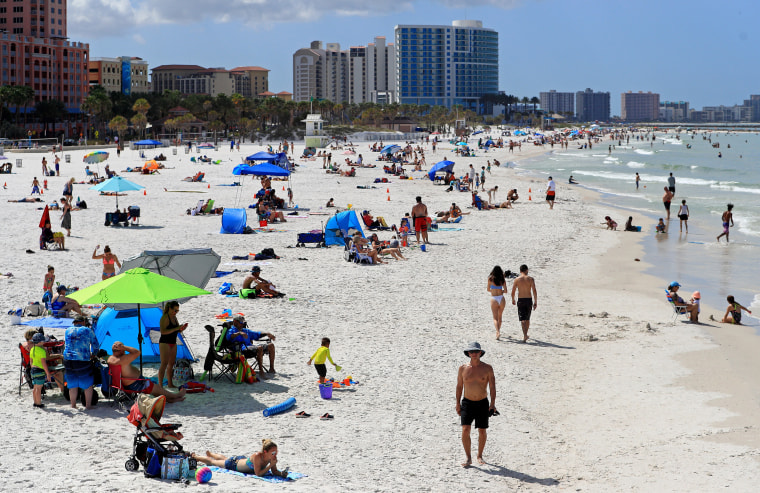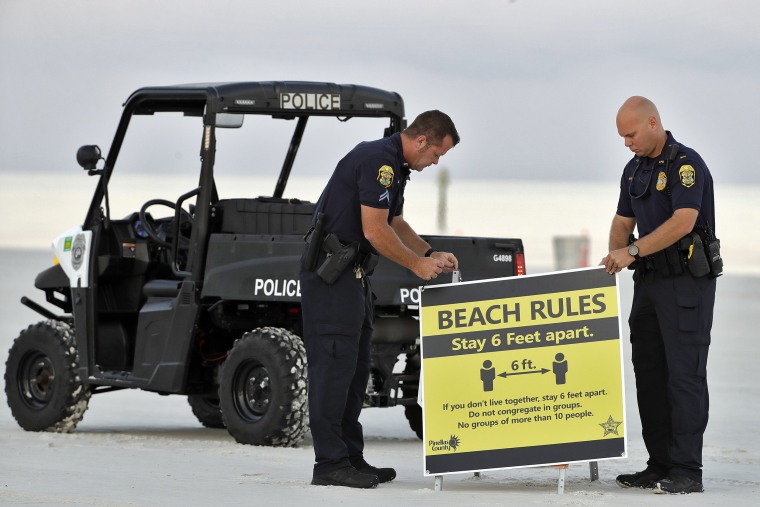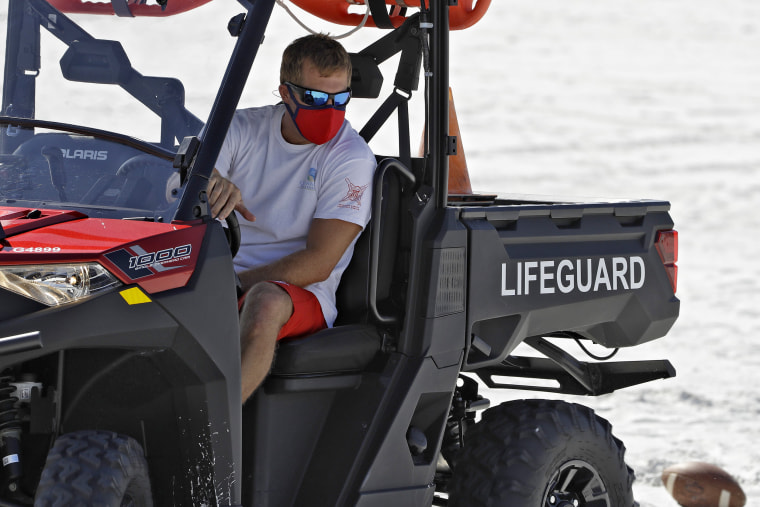A swimmer cries out for help. The lifeguard races to the rescue. And before they reach the water, the coronavirus risk calculation begins.
Every lifeguard reckons with the knowledge that to save a life they could lose their own, that the person they are trying to rescue can potentially pull them down, as well.
But in the age of the coronavirus there is an extra level of danger, lifeguards say, because staying six feet away from a person who is drowning is not an option.
“When we swim out to a victim in distress, it depends on their condition,” said Patrick Brafford, the longtime lifeguard supervisor at Clearwater Beach, Florida. “If they can manage, we will hand them a flotation device for them to hold onto and then we can swim them into shore while keeping a safe distance.”

“But if they’re in dire condition and cannot keep themselves afloat, we’re going to have to make direct contact with them and secure them onto the rescue can,” he said. “That is something all lifeguards have to understand and assume that risk.”
Clearwater Beach, a popular 1.5-mile jewel of white sand and blue water, made headlines for all the wrong reasons in March when images of revelers frolicking in the midst of the pandemic were broadcast nationally -- and after Florida Gov. Ron DeSantis initially balked at banishing the throng from the beach.
Brafford said that his team of 10 full-time and 21 part-time lifeguards haven’t had to do any water rescues since Clearwater Beach reopened May 4. But as the sand fills with beachgoers, the lifeguards have been training for what he calls “the new norm.”
“For us, that’s the biggest thing,” he said. “We’re used to going up and touching and talking to people who need our help. We’ve got to slow it down now.”
Tom Gill, a spokesman for the nonprofit United States Lifesaving Association, agreed.
“At the end of the day, there are going to be times when you have to get really close,” he said. “But there are lots of ways to minimize the impact.”
In response to the pandemic, the USLA issued new suggested guidelines which recommended, among other things, to “avoid touching other people, including your fellow lifeguards, unless necessary.”
“It does not ensure prevention of disease transmission, but lessens the likelihood,” the directive states. “Universal precautions should include at a minimum –- gloves, N95 mask, and eye protection.”
Gill said many of these “common sense” recommendations had been put into place before the pandemic when HIV and other communicable diseases were the main threats.

Also, Americans who grew up watching “Baywatch” might be surprised to find out that lifeguards rarely have to rescue people from the water and that the biggest part of their job is preventing people from getting into trouble.
The USLA reported that in 2018, beach attendance topped an estimated 340 million, which is more than the total U.S. population, and that lifeguards issued more than 8.1 million verbal warnings.
Lifeguards were involved in 85,475 rescues and there were 25 drownings on guarded beaches, according to the USLA.
“And those are just the USLA certified beaches,” Gill said. “That doesn’t include the beaches that are not guarded.”
Since the start of the pandemic, masks, gloves and eye protection have become part of the uniform for lifeguards patrolling Clearwater Beach, Brafford said.
“Up in the (lifeguard) towers, they are self-isolated from the public so the PPE is optional,” he said.
The minute they hit the sand, however, “the PPE is on,” he said.
In an emergency, Brafford said, “all patients are addressed from a six-foot bubble from which we will determine whether this is a life, or non-life-threatening emergency.”
“If there is an immediate emergency, lifeguards will wear gloves, N95 masks and eye protection, break the bubble and make contact with the patient,” he said. “But we still have to be disciplined. We have to slow things down a bit to protect ourselves and others. We don’t want to risk the chance of exposure to our staff unless it is absolutely necessary. We concentrate on better incident management by being more efficient with the resources we have at our disposal while still giving the best possible care to the patient."
But if the emergency means hitting the water, the mask is gone.
“By the very nature of our profession, PPE does not work well in aquatic rescues,” Brafford said.
That said, the lifeguards in the water coordinate closely with fire rescue teams to make sure they are on the sand and ready to provide first aid once the stricken swimmer is brought to shore, he said. Lifequards in the water will use hand signals to communicate with the team waiting on the beach.
The Clearwater Police Department patrols the beach and enforces the social distancing rules, although the lifeguards are also expected to instruct beachgoers to stay six feet apart, Brafford added. When the beach was closed, lifeguards helped the police guard the entry points to keep people out.
“Since we’ve opened most people have been very cooperative, but there have been fewer than normal people out there,” he said.
Even before the pandemic, lifeguards were taking preventative steps against communicable diseases like not using mouth-to-mouth resuscitation and following American Heart Association guidelines, which put the emphasis on chest compressions.
Now, rescuers use plastic barrier devices to safely blow air into a victim’s lungs, Brafford said.

